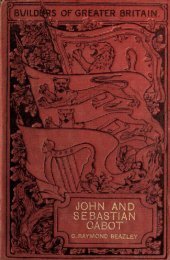st. john of damascus (676-749 - Cristo Raul
st. john of damascus (676-749 - Cristo Raul
st. john of damascus (676-749 - Cristo Raul
You also want an ePaper? Increase the reach of your titles
YUMPU automatically turns print PDFs into web optimized ePapers that Google loves.
"<br />
"<br />
"<br />
84 ST. JOHN OF DAMASCUS.<br />
to surmount the difficulty<br />
by sugge<strong>st</strong>ing a new piece<br />
<strong>of</strong> subtilty, that like as a man s body takes in daily<br />
additional matter, and all becomes one and the same<br />
body, so our Lord s personal body takes in all the newmade<br />
bodies <strong>of</strong> the Euchari<strong>st</strong> ;<br />
and thus, by a kind<br />
<strong>of</strong> growth or augmentation,<br />
all become one and the<br />
same personal body <strong>of</strong> Chri<strong>st</strong>. A marvellous thought !<br />
But he was wedded to a new scheme." This new<br />
scheme," <strong>of</strong> which Waterland makes John <strong>of</strong> Damascus<br />
a votary, was the cause <strong>of</strong> image-worship. Upon<br />
this, in fact, Waterland lays the blame <strong>of</strong> much <strong>of</strong><br />
the innovation in theory which about this time began<br />
to prevail respecting the Holy Euchari<strong>st</strong>. "The<br />
bread and wine,"<br />
Damascenus goes on to say ( 271),<br />
is not a type <strong>of</strong> the body and blood <strong>of</strong> Chri<strong>st</strong> God<br />
:<br />
forbid ! but the very deified body <strong>of</strong> the Lord."<br />
Commenting upon language like this, Waterland<br />
tells us that the next time this new doctrine<br />
appeared upon the <strong>st</strong>age was in the service <strong>of</strong> imageworship,<br />
then creeping into the Church. They who<br />
opposed that innovation, kept up the ancient principle<br />
with regard to the elements <strong>of</strong> the Euchari<strong>st</strong> as<br />
symbols, figures, images ; pleading that our Lord had<br />
left no visible image <strong>of</strong> Himself, His incarnation,<br />
passion, sacrifice, &c., but that <strong>of</strong> the Euchari<strong>st</strong>. In<br />
reply to that plea, the innovators remon<strong>st</strong>rated again<strong>st</strong><br />
the symbolical nature <strong>of</strong> the Euchari<strong>st</strong>, contending<br />
that the consecrated elements were no images, types,<br />
or figures, but the very body and blood <strong>of</strong> Chri<strong>st</strong>,<br />
1<br />
literally Near as the language <strong>of</strong> Damascenus<br />
so."<br />
"<br />
1<br />
Epi<strong>st</strong>. ad Zachariam," p. 197.
















